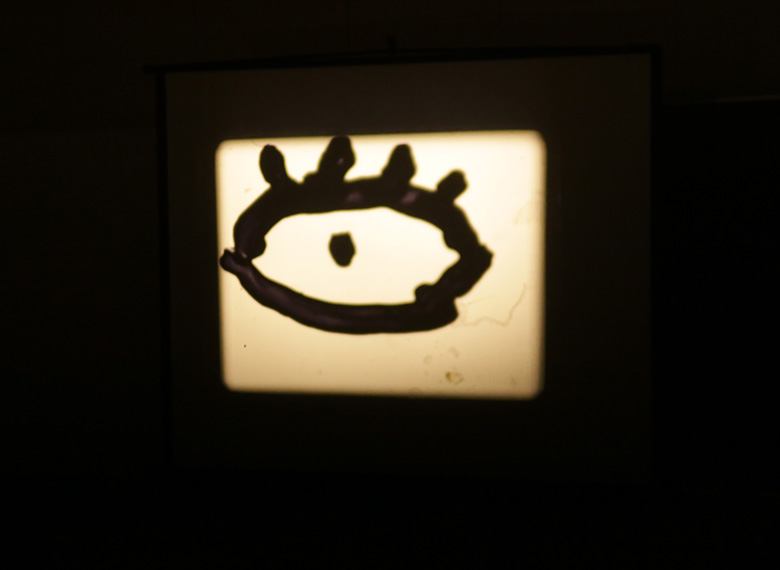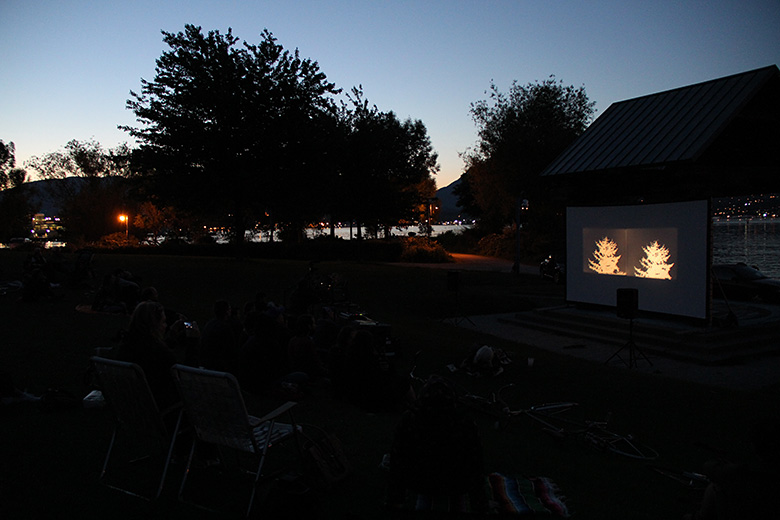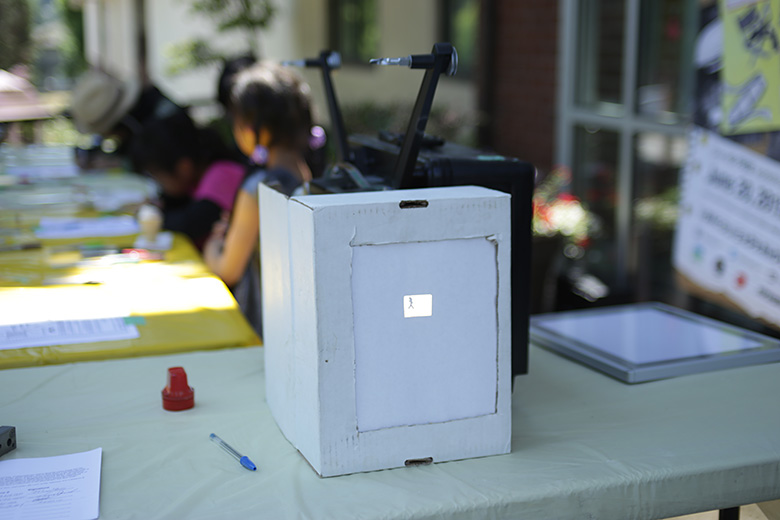An iris is a simple device, one of the oldest in the history of cinema. While its uses are manifold, the technique traditionally serves to open or close a discrete scene: an adjustable black aperture stop contracts and isolates the center of the frame before consuming it entirely, or visa-versa.
Today, even when employed in this seemingly functional fashion, its inclusion more often doubles as a self-aware nod to silent cinema and the mechanics of filmmaking. Another established and essential use of the iris, however, is to direct the eye: literally circling in on a specific locus rather than engulfing it entirely, drawing attention to a detail or action that may have gone unnoticed. It is this practice that most resonates when discussing the work of Vancouver’s Iris Film Collective. In less than two years’ time the collective of “curators, programmers, filmmakers, community activists, and artists” has emerged as a vital presence for celluloid-based filmmaking, directing the eyes of Vancouverites towards the works of young local filmmakers, Berlin’s OJOBOCA, and Montreal’s like-minded Double Negative Collective, as well as towards the city itself, presenting films in micro-cinemas, institutions, and parks—culminating in their current residency in the Falaise Park Fieldhouse.
Such productivity belies the narrow scope that the name Iris might suggest. The collective facilitates workshops, artist talks, dinners, open screenings, residencies, retrospectives, as well as showcases of their own work. While this is a varied array of activities and events, one notes a frequent return to the twin concerns of celluloid film exhibition and community engagement. Iris clearly believes that the magic of film need not reside in any rarified novelty factor, that engaging with and promoting its tactility not only promotes new connections between individuals and the medium, but also between audiences and community members.
Luma caught up with Iris constituents Ariel Kirk-Gushowaty (akg), Alex Mackenzie (am), Lisa G Nielsen (lgn), Ryder White (rw), and Zoe Kirk-Gushowaty (zkh) to discuss their continued investment in celluloid production and exhibition, the benefits of working on a smaller scale, balancing programming with production, and their affinity for independent film labs.
LUMA: The details of the individual collective members aren’t currently available on your website. Can you speak to your decision to present Iris as a discrete entity (at least online)?
IRIS: I think our intention is to highlight the collective aspect and not so much the individuals—we all have art practices of our own that may or may not diverge from moving images and more specifically celluloid, but we see those as somewhat distinct from our collective pursuits, as much as they do cross over at times. Of course, screenings of our work are the moment where we do announce our membership more publicly. I don’t think we are averse to adding a note about the members in future, but we also recognize that the membership may fluctuate and shift as time goes on, so the idea of a singular collective identity seems a strength at this point. (am)
LUMA: I’d love to learn more about the genesis of the collective. Several of the collective members have been involved in film for some time, yet Iris is relatively young. Was there one specific imperative that became a driving force behind your formation?
IRIS: The group coalesced around a common interest that was spawned both from getting to know each other at local film-based workshops and a sense that a distinct entity beyond what already existed in the more formal shape of the Vancouver art scene was seen as a sensible approach. Instead of folding into something that already existed, why not create a more vibrant scene by growing it out a little? In this way we can collaborate with other organizations but also be free to pursue more collective-specific ideas and ideals. (am)
Many of us worked on our own pieces based around a film/live performance challenge for Art Waste in 2013…We all felt pretty good about the night and were excited at the idea that a group of us working together could spur each other to generate more work in the future...it kind of grew from there (lgn)
From a dimly lit underpass, to construction sites, tennis courts, or an abandoned polar bear cage, our list only seems to get longer.
LUMA: There are a number of outlets for experimental moving image art in Vancouver—DIM Cinema, Cineworks, as well as VIVO Media Arts and their Signal + Noise festival—but Iris has already established itself as a unique (and prolific) outlet for experimental film and art. Can you say a few words about non-traditional film exhibition in Vancouver and where Iris fits within Vancouver’s expanded media arts firmament?
IRIS: Vancouver is still a small city and non-traditional film exhibition holds only a tiny corner of the arts scene proper. While cine-film has transformed significantly in the past decade, there has been a noted reinvigoration on the small scale, handmade level that interests us both as exhibitors and makers. There is obviously a lot of room for growth and in the last decade or so the screening opportunities have been scarce so we are happy to create space for more viewing opportunities and to generally increase the visibility of the medium. (am)
We are trying to share film with as many people as possible and there is something to be said about screening film in surprising places. Outdoor screenings can be a great way to expose folks to film who wouldn’t normally attend a traditional screening at a cinema. That said, by partnering with existing film interested entities like the ones you list is an effort to continue building a film community that is already here! (lgn)
LUMA: In the 18 months since Iris’ formation you’ve exhibited films in smaller venues like Cineworks, at the Cinematheque, and at outdoor screenings across the city. As everyone knows, space in Vancouver these days comes at a high price. I’m curious to know the relation between works you show and how they’re exhibited. How does Iris’ nomadic nature define your identity and programming vision? To what extent do the works determine the ideal space or vice-versa?
IRIS: We have had many conversations about screening venues and approaches to presentation as it has such a significant impact on both the perception and reception of the work, as well as a consideration for building up and out a community that can participate. We hope to crossover with more groups in the future to increase visibility and pique the interest of individuals who may not have come across this kind of work before. (am)
Iris has an ongoing mission to seek and explore the city for alternative screening spaces. From a dimly lit underpass, to construction sites, tennis courts, or an abandoned polar bear cage, our list only seems to get longer. Since the beginning I think we all shared the motivation to make and exhibit work that does not necessarily belong in typical cinema or gallery spaces hence our lexicon of dark corners to light up is always expanding. Sometimes we seek out a space for a specific screening, other times we play matchmaker. (zkh)
It is maybe a partial function of the cost of facilities in Vancouver, too, but the kind of work we program is not particularly accessible in our community. I think there's a desire in our group to provide the work that we make and enjoy in public space where no one needs to feel prohibited by cost, lack of knowledge, or the closed ranks of an artistic clique. (rw)
We have also tried to keep ourselves pretty nimble in terms our operational structure so that we stay open to a wider variety of opportunities than some of our other more institutional colleagues are able to. (rw)
LUMA: This might be a good opportunity to speak about your current residency at Falaise Park Field House, which continues through 2017.
IRIS: The Fieldhouse residency has really allowed us to develop and grow together as a group and will continue to do so over the next few years that we have it. Having a common and consistent space to work and meet in as well as a venue to accommodate monthly archive screenings and artist talks has really helped to establish our sense of place in the community. (zkh)
Since getting the keys in January 2015, Iris has really transformed the Fieldhouse into a really great space to make work. We just finished our first commission for a project called End of the World and we were certainly animating that space 24-7 in May and June with processing, splicing and printing our new pieces! We did everything in house and it was a real collective experience. Also, it doesn't hurt that we have a great view! (lgn)
The Fieldhouse program is probably one of the most useful and practical programs the City of Vancouver has to offer to artists, and permits us both a clubhouse/meeting space as well as a place to create work. The Fieldhouses are all former caretaker cottages for a number of parks in the city, and as such are small bungalows. So we are not talking about a huge amount of space, but any square footage is, as you say, at a premium in Vancouver, so we welcome the opportunity to have it as a place to hang our hats. (am)
The presence and sound of 16mm projectors has a surprising appeal for the uninitiated.
LUMA: Several of your events foster a collapse between the screen and the audience, utilizing film not only as entertainment but a means to foster community building. I’m thinking here of initiatives like your recent all-ages drawing-on-film workshop as part of the city-wide Vancouver Draw Down initiative and your monthly Sunday Supperspeaker series. Of course, a key element of this is Iris’ interest in the use of celluloid—unlike the impenetrable black box of a Digital Cinema Package, you remain invested in film as a tangible material. What sort of connections do you identify between celluloid and community and why does celluloid hold such an allure?
IRIS: Celluloid does carry a certain element of community in that it is a way of gathering a group of people together to experience something collectively—the analog aspect only seems to enhance this quality, in some ways a throwback but also bringing a kind of warmth that might be lacking in the digital realm. The presence and sound of 16mm projectors has a surprising appeal for the uninitiated. There are many who have only ever seen pictures of film projectors, so this is a real chance to get their hands on the material or at least observe the magic of the machinery in action. (am)
Kids, in particular, are highly attracted to tangible projects, and things like Draw Down create a cheap and highly adaptable way for them (and everyone) to be introduced to the medium. There is also a one-to-one relationship between film and image that is appealing...light shines through a small image and it makes a bigger one...you don't need a computer science degree to get it. And at the risk of getting a little bit overly intellectual, film has an indexical quality of preservation that the technologically symbolic system of digital imaging, by definition, cannot. Finally, of course, film is a little bit exclusive because it is such hard work to make...I think the uniqueness of the format makes a lot of people pay attention. (rw)
LUMA: Can you speak a little about the Iris Film Archive and your monthly screenings? I like that your archival screenings also double as an open screening, inviting audiences to arrive with “anything you might be inclined to bring by.” The call seems to invite vintage prints, but is open enough practitioners might bring their own, new works. For all that you assemble thoughtful programs you seem equally eager to allow for unexpected connections. How does this interplay between “old” and new works—linked through a lineage of celluloid—fit into Iris’ broader mission?
IRIS: The archive screenings were originally based on sorting through a 1500+ 16mm print collection that belongs to one of our members to simply see what surprised that collection holds. The prints come from a broad range of sources, primarily educational collections that were deleted from schools, colleges, universities and government organizations. The idea of blending that with a “bring your own film” creates a great opportunity for serendipity and lowers the fear factor some newer makers feel in finding a way to present their work. It is a process of discovery for all and we hope will lead to future programs that are built from what we find. (am)
On August 16 Iris will host another installment of their Sunday Supper series with Erin Siddall in Strathcona. On August 30 they will present their Mining the Collective Archive Screening at Falaise Fieldhouse. For more information about upcoming Iris screenings, workshops, and other events visit irisfilmcollective.tumblr.com.





